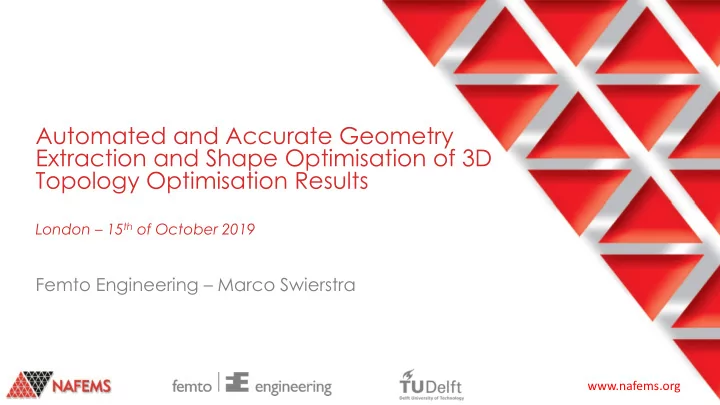

Automated and Accurate Geometry Extraction and Shape Optimisation of 3D Topology Optimisation Results London – 15 th of October 2019 Femto Engineering – Marco Swierstra www.nafems.org
Introduction – Topology optimisation • Design requirements – Boundary conditions – Variables: material placement – Objective: maximum stiffness (minimum compliance) – Constraint: limit amount of material used www.nafems.org 2
Introduction – Topology optimisation Post-processing Design Topology Optimised design requirements optimisation jagged boundaries intermediate densities www.nafems.org 3
Introduction – Post-processing • Goals – Automatic – Accurate and optimised – 3D Stage 1 Stage 2 Stage 3 Design Topology Geometry Shape Optimised design requirements optimisation extraction optimisation post-processing www.nafems.org 4
Contents • Structural design optimisation (2D) Stage 1. Topology optimisation (TO) Stage 2. Geometry extraction Stage 3. Shape optimisation • Case studies (3D) • Performance • Conclusions www.nafems.org 5
Geometry extraction jagged boundaries intermediate densities image processing smooth crisp www.nafems.org 6
Level Set Function (LSF) Radial Basis Function (RBF): • • Sum RBFs to Level Set Function (LSF): www.nafems.org 7
Topology optimised result to LSF Solve set of linear equations • RBF at every element • LSF equals TO density value at every element centre location • LSF is fully positive www.nafems.org 8
LSF to smooth density field (1) • • Heaviside function www.nafems.org 9
LSF to smooth density field (2) www.nafems.org 10
Shape optimisation Stage 1 Stage 2 Stage 3 Design Topology Geometry Shape Optimised requirements optimisation extraction optimisation design • Not an optimised design anymore • Image interpretation – no mechanics • Variables: weights 𝑥 𝑗 of Radial Basis Functions • Two tools: structural analysis and sensitivity analysis www.nafems.org 11
Structural analysis • Same mesh as topology optimisation • p -FEM + quadtree integration = Finite Cell Method www.nafems.org 12
Sensitivity analysis • Gradient-based optimisation density at integration points objective weights RBFs are Level Set Function design variables at integration points www.nafems.org 13
Shape optimisation www.nafems.org 14
Summary three-staged procedure Design Topology Geometry Shape Optimised requirements optimisation extraction optimisation design Stage 1 Stage 2 Stage 3 www.nafems.org 15
Case studies (1) www.nafems.org 16
Case studies (2) www.nafems.org 17
Performance – computation time (1) • Post-processing takes more time on average • Prototype Python implementation • Similar quality using TO alone is less efficient Computation times (s) for the case studies. Case study Grid size Stage 1 Stage 2 Stage 3 Stage 2 + 3 2D MBB 64 x 32 20 1 22 53% 2D Cantilever 180 x 120 371 6 167 32% 3D MBB 64 x 10 x 32 1,203 53 3,108 72% 3D Cantilever 30 x 30 x 30 1,454 80 2,369 63% www.nafems.org 18
Performance computation time (2) 64 x 32 grid 20 extra TO iterations 20 extra TO iterations 3-staged process took 25 seconds took 262 seconds took 23 seconds 128 x 64 grid 256 x 128 grid 64 x 32 RBFs www.nafems.org 19
Performance – accuracy www.nafems.org 20
Conclusions • Automatically smooth and optimised designs • Almost no intermediate densities • Computation times are high (or low?) • No remeshing, still sufficient analysis accuracy • Easily extendable to other types of optimisation problems www.nafems.org 21
Thank you very much! The Netherlands oude delft 137, 2611 be delft po box 2854, 2601 cw delft t: +31 15 285 05 80 f: +31 15 285 05 81 ms@femto.eu www.femto.eu engineering innovation www.nafems.org 22
Recommend
More recommend